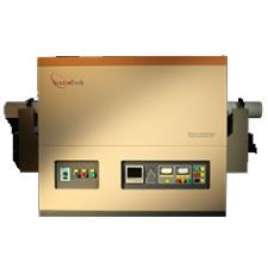
Regular Cleaning of Your Tube Furnace
Regular cleaning is an essential part of vacuum tube furnace maintenance. Over time, deposits from high-temperature processes can accumulate on the walls and heating elements of the furnace, reducing its efficiency and potentially causing damage. Here are the basic steps to take when cleaning your tubular furnace.
- Step 1: Start by allowing it to cool down completely. Then, using a soft brush or vacuum, remove any loose debris from the inside of the furnace. Be careful not to damage the heating elements or the insulation while cleaning.
- Step 2: Mix a solution of water and a mild detergent and apply it to a clean cloth. Gently wipe down the interior of the furnace, focusing on areas with visible deposits. Be sure to avoid any electrical components or heating elements while cleaning.
- Step 3: Rinse the cloth in clean water and wring it out before wiping down the furnace again. Repeat the process until all detergent residues are removed, and then use a clean, dry cloth to wipe down the furnace one last time.
It's important to note that the cleaning frequency will depend on the usage and the specific requirements of the furnace. Some high-temperature vacuum tube furnaces may need to be cleaned after every use, while others may require cleaning only once a month. Always refer to the manufacturer's instructions for the recommended cleaning frequency.
In addition to regular cleaning, it's important to have a maintenance schedule in place to ensure that the furnace is inspected and serviced regularly. By following a regular cleaning and maintenance schedule, you can help prolong the lifespan of your furnace and ensure that it continues to operate efficiently.
Tube Furnace Seal Inspection and Replacement
The seal on a vacuum tube furnace helps maintain the vacuum or controlled atmosphere inside the furnace. Over time, the seal can become damaged or worn, resulting in air leaks that can compromise the furnace's performance and accuracy.
- Start by visually examining it for any visible signs of wear or damage.
- Perform a pressure test to check for any air leaks.
- If the seal is damaged or worn, it should be replaced immediately to avoid any further damage to the tube furnace.
- Use corresponding replacement parts that match your tube furnace's original design.
It is essential to use the correct seal for your tubular furnace. Using the wrong seal can lead to air leaks or even cause the furnace to fail. When ordering a replacement seal, make sure to specify the correct dimensions and materials.
The replacement process will vary depending on the type of seal used in your small tube furnace, so it's important to refer to the manufacturer's instructions for guidance. Regular seal inspection and replacement should be part of your vacuum tube furnace maintenance schedule. By keeping the seal in good condition, you can help ensure that your furnace operates efficiently and accurately, producing consistent results.
Tube Furnace Heating Element Inspection
The heating elements in a vacuum tube furnace are the components that provide the heat necessary for high-temperature processes. These elements are exposed to extreme temperatures, which can cause wear and tear over time. Proper heating element maintenance is critical to the overall performance and longevity of the furnace.
Check your lab tube furnace heating elements regularly for any visible signs of damage, such as cracks or breaks. If any damage is detected, the heating element should be replaced immediately. Regularly cleaning the heating elements is also important to remove any accumulated debris or residue that can reduce efficiency. Use a soft brush or vacuum to remove any loose debris, taking care not to damage the elements or the insulation.
It's important to note that any maintenance or repair work on the heating elements should only be carried out by a qualified technician. Attempting to repair or replace the elements yourself can be dangerous and can cause damage to the furnace. Regular heating element maintenance is essential to keep your vacuum tube furnace in good working condition.

Common Tube Furnace Problems and Troubleshooting
Despite regular maintenance, vacuum tube furnaces can still experience problems. Here are some common issues you may encounter and troubleshooting steps to address them:
1. Temperature Fluctuations
If your furnace is experiencing temperature fluctuations, check the thermocouple or temperature controller. It may need to be recalibrated or replaced.
2. Vacuum Leaks
Check the seals and gaskets if you notice a decrease in vacuum or pressure. Tighten any loose fittings, and replace any damaged or worn-out seals.
3. Overheating
Overheating is a common cause from damaged, worn or faulty heating elements. Adjust the temperature controller settings to prevent the tubular furnace from overheating. Inspect each element and replace accordingly.
4. Power Issues
Supply failure is a common cause of power issues. If the lab tube furnace won't turn on or is having power issues, check the power supply and wiring for any damage or loose connections. You may need to repair or replace any damaged components.
5. Gas Flow Issues
If your small tube furnace is using a gas supply, check the gas flow and pressure. Make sure the gas supply is turned on, and check the valves and regulators for any damage or leaks.
If you encounter a problem with your vacuum tube furnace that you cannot resolve, contact a qualified technician or the manufacturer's customer support for assistance. By addressing problems as soon as they arise, you can help ensure that your lab tube furnace operates efficiently and produces accurate results for your high-temperature processes.
Frequently Asked Questions About Vacuum Tube Furnace Maintenance
Have questions about vacuum tube furnace maintenance? Here are some frequently asked questions and answers to learn more about tubular furnaces and how to maintain them.
How Often Should I Clean My Vacuum Tube Furnace?
It's recommended to clean your vacuum tube furnace after each use to remove any residue or particles that may have accumulated on the heating elements or chamber. Additionally, perform a thorough cleaning at least once a month to ensure optimal performance.
How Do I Know If My Vacuum Seal Is Leaking?
A decrease in vacuum or pressure is a common indication of a vacuum seal leak. To locate the leak, perform a vacuum leak check by introducing a gas into the chamber and observing the pressure gauge. You can also use a vacuum leak detector to help locate the source of the leak.
Can I Perform Maintenance on My Furnace or Do I Need to Hire a Professional?
It's generally recommended to hire a qualified technician to perform maintenance on your vacuum tube furnace. However, if you have experience and knowledge of vacuum furnace systems and their components, you may be able to perform some basic maintenance tasks yourself. Always refer to the manufacturer's instructions and guidelines when performing maintenance or repairs on your tubular furnace.
Get Tube Furnace Maintenance and Replacement Parts From Sentro Tech
If you're in need of tube furnace maintenance or replacement parts, look no further than Sentro Tech. With years of experience and a commitment to quality, Sentro Tech provides top-of-the-line vacuum tube furnaces for a variety of industrial applications. Get a lab tube furnace for research and development or a small tube furnace for sintering, tempering and other metallurgical processes. Whether you need routine cleaning and maintenance, a complete overhaul or a brand-new custom-built tubular furnace, Sentro Tech is the premier name in industrial ovens, parts and accessories. Contact us today to learn what Sentro Tech can do for you.
Contact Us



